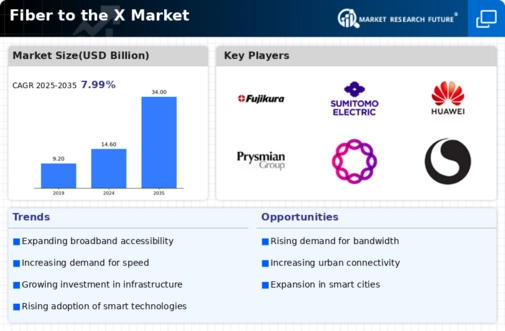Rising Adoption of Cloud Services
The Fiber to the X Market is significantly influenced by the rising adoption of cloud services among businesses and consumers. As organizations increasingly migrate their operations to the cloud, the demand for high-speed, reliable internet connections intensifies. This trend is evident in the data, which indicates that cloud service revenues are projected to grow at a compound annual growth rate of over 20%. Consequently, businesses are seeking fiber optic solutions to ensure seamless access to cloud applications and data storage. The Fiber to the X Market stands to gain from this shift, as service providers enhance their infrastructure to support the bandwidth requirements of cloud computing. This evolution not only fosters competition among providers but also encourages innovation in service delivery, ultimately benefiting end-users.
Expansion of Smart City Initiatives
The Fiber to the X Market is poised to benefit from the expansion of smart city initiatives across various regions. Governments are increasingly investing in digital infrastructure to enhance urban living, which includes the deployment of fiber optic networks. These initiatives aim to improve public services, transportation systems, and energy management through advanced connectivity. For instance, cities that have integrated fiber networks report improved efficiency in traffic management and public safety systems. The market data suggests that investments in smart city projects could exceed several billion dollars in the coming years, creating a favorable environment for the Fiber to the X Market. As municipalities seek to modernize their infrastructure, the demand for fiber connectivity is expected to rise, driving growth and innovation within the industry.
Increasing Consumer Demand for Bandwidth
The Fiber to the X Market is experiencing a notable surge in consumer demand for higher bandwidth. As digital consumption rises, driven by streaming services, online gaming, and remote work, the need for robust internet connectivity becomes paramount. Reports indicate that households are increasingly opting for fiber connections, with a projected increase in fiber subscriptions by over 30% in the next few years. This trend suggests that service providers must enhance their offerings to meet consumer expectations, thereby propelling the Fiber to the X Market forward. The shift towards smart homes and IoT devices further amplifies this demand, as these technologies require stable and high-speed internet access. Consequently, the industry is likely to witness significant investments aimed at expanding fiber networks to accommodate this growing need.
Government Policies Promoting Fiber Infrastructure
The Fiber to the X Market is significantly shaped by government policies aimed at promoting fiber infrastructure development. Various governments are implementing initiatives to encourage investment in broadband networks, recognizing the importance of high-speed internet for economic growth and social inclusion. For instance, funding programs and subsidies are being introduced to support the deployment of fiber networks in underserved areas. Market data suggests that these initiatives could lead to an increase in fiber coverage by over 40% in the next five years. Such policies not only stimulate competition among service providers but also enhance the overall quality of internet services. Consequently, the Fiber to the X Market is likely to thrive as governments continue to prioritize digital infrastructure as a critical component of national development strategies.
Technological Innovations in Fiber Optic Solutions
The Fiber to the X Market is witnessing a wave of technological innovations that enhance fiber optic solutions. Advancements in fiber deployment techniques, such as micro-trenching and aerial installations, are reducing costs and installation times. These innovations enable service providers to expand their networks more efficiently, thereby increasing accessibility to fiber connections. Moreover, the development of new fiber materials and technologies, such as bend-insensitive fibers, is improving performance and reliability. Market data indicates that the adoption of these technologies could lead to a reduction in deployment costs by up to 25%. As a result, the Fiber to the X Market is likely to experience accelerated growth, as providers can offer competitive pricing while expanding their service areas.

















Leave a Comment